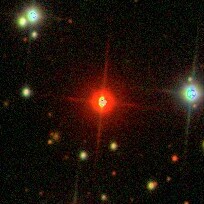Top Qs
Timeline
Chat
Perspective
Wolf 1069
Red dwarf star in the constellation Cygnus From Wikipedia, the free encyclopedia
Remove ads
Wolf 1069 is a red dwarf star located 31.2 light-years (9.6 parsecs) away from the Solar System in the constellation of Cygnus. The star has 17% the mass and 18% the radius of the Sun, a temperature of 3,158 K (2,885 °C; 5,225 °F), and a slow rotation period of 150–170 days. It hosts one known exoplanet called Wolf 1069 b which could possibly sustain life.[4]
Remove ads
Planetary system
A planetary companion to Wolf 1069 was discovered in 2023 via radial velocity. It has a minimum mass close to that of Earth and orbits within the habitable zone of its star, with an orbital period of 15 days. This planet does not transit its host star. Observations have ruled out any additional planets greater than one Earth mass with orbital periods of less than 10 days.[4]
As of its discovery, Wolf 1069 b is the sixth-closest known Earth-mass planet within the conservatively defined habitable zone, after Proxima Centauri b, GJ 1061 d, Teegarden's Star c, and GJ 1002 b & c.[4]
Remove ads
Notes
- The radius of this planet has not been measured; this value is an estimate.
References
Wikiwand - on
Seamless Wikipedia browsing. On steroids.
Remove ads

